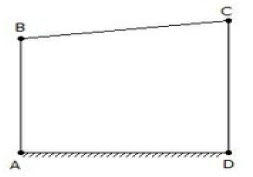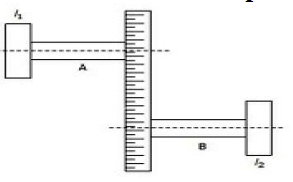Angle of ascent of cam is defined as the angle
During which the follower returns to its initial position
Of rotation of the cam for a definite displacement of the follower
Through which the cam rotates during the period in which the follower remains in highest position
Moved by the cam from the instant the follower begins to rise, till it reaches its highest position
Correct Answer :
D. Moved by the cam from the instant the follower begins to rise, till it reaches its highest position
Related Questions
The type of pair formed by two elements which are so connected that one is constrained to turn or revolve about a fixed axis of another element is known as
Turning pair
Rolling pair
Sliding pair
Spherical pair
A slider crank chain consists of following numbers of turning and sliding pairs
1, 3
2, 2
3, 1
4, 0
The two links OA and OB are connected by a pin joint at O. If the link OA turns with angular velocity ω₁ rad/s in the clockwise direction and the link OB turns with angular velocity ω₂ rad/s in the clockwise direction, then the rubbing velocity at the pin joint O is (where r = Radius of the pin at O)
ω₁.ω₂.r
(ω₁ - ω₂)r
(ω₁ + ω₂)r
(ω₁ - ω₂)2r
The dynamic friction is the friction experienced by a body, when the body
Is in motion
Is at rest
Just begins to slide over the surface of the other body
None of the above
The mechanism consisting of three turning pairs and one sliding pair, is called a
Single slider crank chain
Whitworth quick return motion mechanism
Crank and slotted lever quick return motion mechanism
All of the above
Which of the following statement is wrong?
The difference between the maximum and minimum energies is called maximum fluctuation of energy
The coefficient of fluctuation of speed is the ratio of maximum fluctuation of speed to the mean speed
The variations of energy above and below the mean resisting torque line is known as fluctuation of energy
None of the above
ABCD is a four bar mechanism in which AB = 310 mm and CD = 450 mm. AB and CD are both perpendicular to the fixed link AD, as shown in the below figure. If the velocity of B at this condition is v. Then the velocity of C is 
v
(2/3). v
(3/2). v
(9/4). v
A disturbing mass m₁ attached to the rotating shaft may be balanced by a single mass m₂ attached in the same plane of rotation as that of m₁, such that (where r₁ and r₂ are the radii of rotation of m₁ and m₂ respectively)
m₁r₂ = m₂r₁
m₁r₁ = m₂r₂
m₁m₂ = r₁r₂
None of these
The essential condition of placing the two masses, so that the system becomes dynamically equivalent, is (where l₁ and l₂ = Distance of two masses from the centre of gravity of the body, and kG = Radius of gyration of the body)
l₁ = kG
l₂ = kG
l₁l₂ = kG
l₁l₂ = kG²
A torsional system with discs of moment of inertia I₁ and I₂ as shown in the below figure, is gear driven such that the ratio of speed of shaft B to shaft A is 'G'. Neglecting the inertia of gears, the equivalent inertia of disc on shaft B at the speed of shaft A is equal to 
G.I₂
G².I₂
I₂/G
I₂/G²
Which of the following mechanism is an approximate straight line motion mechanism?
Watt's mechanism
Grasshopper mechanism
Robert's mechanism
All of these
The engine of an aeroplane rotates in clockwise direction when seen from the tail end and the aeroplane takes a turn to the left. The effect of gyroscopic couple on the aeroplane will be
To dip the nose and tail
To raise the nose and tail
To raise the nose and dip the tail
To dip the nose and raise the tail
Relationship between the number of links (L) and number of pairs (P) is
P = 2L - 4
P = 2L + 4
P = 2L + 2
P = 2L - 2
When a point at the end of a link moves with constant angular velocity, its acceleration will have
Radial component only
Tangential component only
Coriolis component only
Radial and tangential components both
In elliptical trammels
All four pairs are turning
Three pairs turning and one pair sliding
Two pairs turning and two pairs sliding
One pair turning and three pairs sliding
The C.G. of a link in any mechanism would experience
No acceleration
Linear acceleration
Angular acceleration
Both angular and linear accelerations
The Grubler's criterion for determining the degrees of freedom (n) of a mechanism having plane motion is (where l = Number of links, and j = Number of binary joints)
n = (l -1) - j
n = 2(l - 1) - 2j
n = 3(l - 1) - 2j
n = 4(l - 1) - 3j
A shaft has an attached disc at the centre of its length. The disc has its centre of gravity located at a distance of 2 mm from the axis of the shaft. When the shaft is allowed to vibrate in its natural bow-shaped mode, it has a frequency of vibration of 10 rad/s. When the shaft is rotated at 300 r.p.m., it will whirl with a radius of
2 mm
2.22 mm
2.50 mm
3.0 mm
The periodic time is given by (where ω = Angular velocity of the particle in rad/s)
ω/2π
2π/ω
ω × 2π
π/ω
The purpose of a link is to
Transmit motion
Guide other links
Act as a support
All of the above
In a circular arc cam with roller follower, the acceleration in any position of the lift will depend only upon
Total lift, total angle of lift, minimum radius of cam and cam speed
Radius of circular arc, cam speed, location of centre of circular arc and roller diameter
Mass of cam follower linkage, spring stiffness and cam speed
Total lift, centre of gravity of the cam and cam speed
For low and moderate speed engines, the cam follower should move with
Uniform velocity
Simple harmonic motion
Uniform acceleration and retardation
Cycloidal motion
When the two elements of a pair have a surface contact when relative motion takes place and the surface of one element slides over the surface of the other, the pair formed is known as a
Lower pair
Higher pair
Self-closed pair
Force-closed pair
The approximate straight line mechanism is a
Four bar linkage
6 bar linkage
8 bar linkage
3 bar linkage
Kinematic pairs are those which have
Point or line contact between the two elements when in motion
Surface contact between the two elements when in motion
Elements of pairs not held together mechanically
Two elements that permit relative motion
The secondary unbalanced force is maximum __________ in one revolution of the crank.
Two times
Four times
Eight times
Sixteen times
In an ideal machine, the output as compared to input is
Less
More
Equal
May be less or more depending on efficiency
In a gear having involute teeth, the normal to the involute is a tangent to the
Pitch circle
Base circle
Addendum circle
Dedendum circle
In a system subjected to damped forced vibrations, the ratio of maximum displacement to the static deflection is known as
Critical damping ratio
Damping factor
Logarithmic decrement
Magnification factor
In a reciprocating engine, usually __________ of the reciprocating masses are balanced.
One-half
Two-third
Three-fourth
Whole
